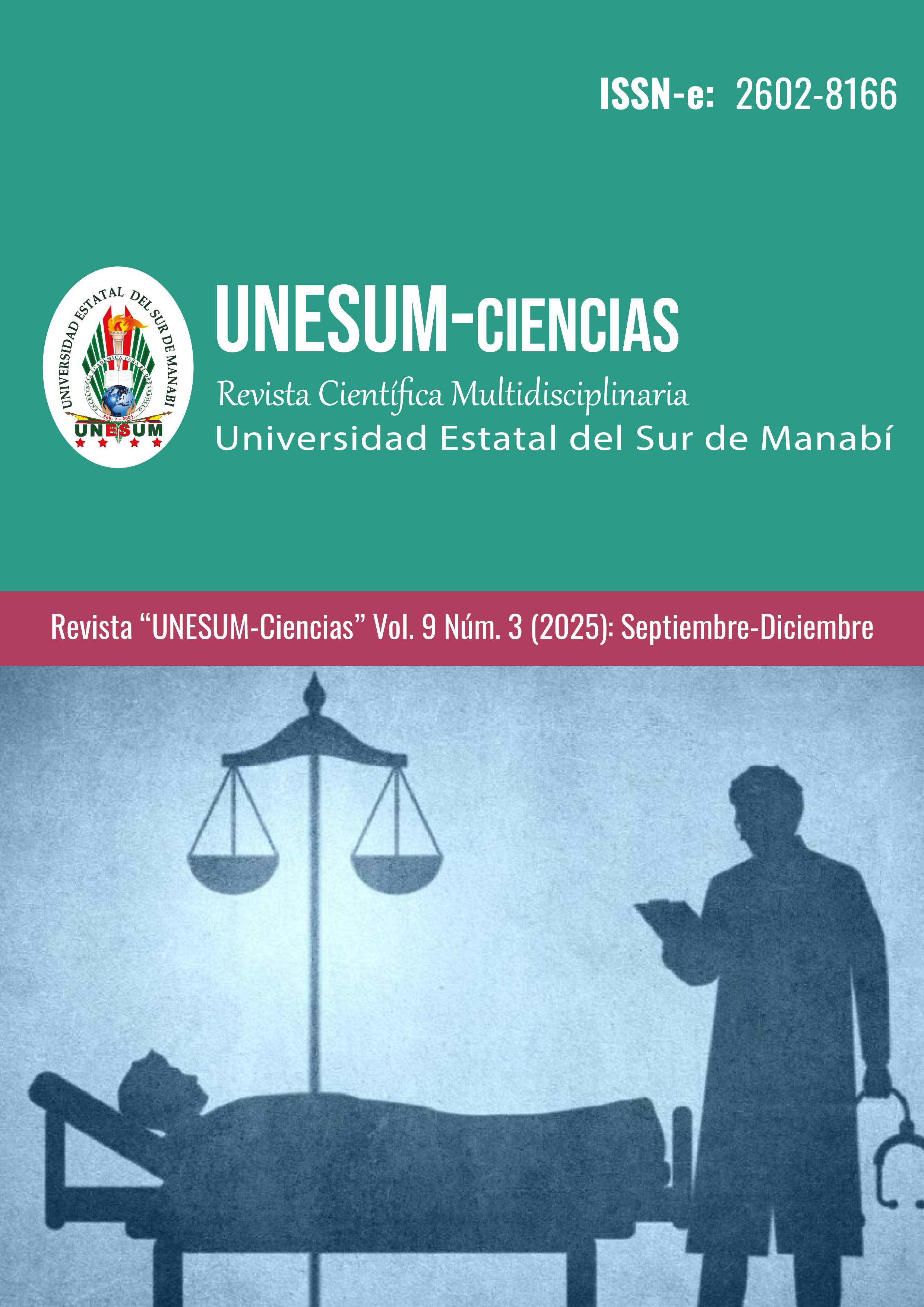Morphological Responses of Six Genotypes of Jatropha curcas L. (Euphorbiaceae) Subjected to Pruning, Manabí, Ecuador
Morphological Responses of Six Genotypes of Jatropha curcas L.
DOI:
https://doi.org/10.47230/unesum-ciencias.v9.n3.2025.304-316Keywords:
Adaptability; vegetative growth; agronomic management; improvement; yield.Abstract
This study evaluated the effect of pruning on six genotypes of Jatropha curcas L. in Manabí, Ecuador. Twenty-four subplots were established in a 0.6 ha area, assessing 192 plants monthly to record height, stem diameter, number of branches, inflorescences, and fruits before and after pruning. Pruning significantly increased the number of branches and inflorescences, with Hybrid JAT 001165 showing the highest number of branches (27.9 on average) and CP 041-promising recording the most inflorescences (5.77). Additionally, stem diameter increased in all genotypes, with JAT 001165 reaching the highest value (11.91 cm). The highest fruit yield was recorded in JAT 001100 (737.3 fruits/plant), while CP 041-promising had the lowest (83.8 fruits/plant). In terms of height, JAT 001100 had the tallest average before pruning (222.72 cm), and JAT 001164 remained the tallest after pruning (206.64 cm). Pruning enhances vegetative and reproductive development in J. curcas, increasing branching, flowering, and stem diameter—key factors for productivity. However, responses vary by genotype, highlighting the importance of proper selection to maximize yield.
Downloads
References
Adeniji, I. T., Togun, A. O., Adediran, J. A., Adeniji, A. M., Ogunwade, O. A., & Omenna, E. C. (2024). Growth and yield of Jatropha curcas L. as influenced by different regimes of apical bud removal. Sustainability, Agri, Food and Environmental Research, 12(2). Recuperado de https://doi.org/10.7770/safer-V12N2-art789
Aguirre-Medina, J. F., Yeekón-Méndez, L., & Espinosa-Zaragoza, S. (2019). Influencia de hongos endomicorrízicos en el crecimiento de (Tabebuia donnell-smithii Rose). Ecosistemas y Recursos Agropecuarios, 6(16), 11-21. Recuperado de https://www.scielo.org.mx/scielo.php?pid=S2007-90282019000100011&script=sci_arttext
Arunyanark, A., Tanya, P., Liangsakul, P., & Srinives, P. (2023a). Biomass productivity and wood chemical composition at different pruning ages of interspecific hybrid Jatropha. Agriculture and Natural Resources, 57(2), 353-362. Recuperado de https://li01.tci-thaijo.org/index.php/anres/article/view/259319
Arunyanark, A., Tanya, P., Liangsakul, P., & Srinives, P. (2023b). Genotype performance and relationship between leaf traits, biomass yield, and wood quality on interspecific hybrids of Jatropha. Agriculture and Natural Resources, 57(2), 309-320. Recuperado de https://www.cabidigitallibrary.org/doi/full/10.5555/20230235291
Arunyanark, A., Foytong, K., Jompuk, C., Srinives, P., & Tanya, P. (2023c). Yield productivity enhancement through reduced plant spacing and pruning tolerance of Jatropha hybrids. Agriculture and Natural Resources. Recuperado de https://www.researchsquare.com/article/rs-3511764/v1
Campuzano, L., Gualdrón, R., & Chávez, F. (2020). Desempeño productivo y adaptación de Jatropha curcas L. en tres ecorregiones en Colombia. Agronomía Mesoamericana, 31(2), 277-290. Recuperado de https://www.scielo.sa.cr/pdf/am/v31n2/2215-3608-am-31-02-00277.pdf
Cezario, L. F. C., Júnior, A. F. D., da Silva, Á. M., Santos, O. N. A., Ucella-Filho, J. G. M., de Paula Protásio, T., ... & Rousset, P. (2023). Irrigation in Jatropha curcas L. cultivation and its effect on biomass for bioenergy generation. Journal of Cleaner Production, 429, 139527. Recuperado de https://www.sciencedirect.com/science/article/abs/pii/S0959652623036855
García-Alonso, F., García-Pérez, E., Pérez-Vázquez, A., Martínez-Martínez, R., & Casanova-Pérez, L. (2023). Morphological and productive characterization of accessions of non-toxic Jatropha curcas L. in the central region of Veracruz. Revista Mexicana de Ciencias Agrícolas, 14(4), 507-518. Recuperado de https://www.scielo.org.mx/scielo.php?pid=S200709342023000400507&script=sci_arttext&tlng=en
Martin, M., & Montes, J. M. (2015). Quantitative genetic parameters of agronomic and quality traits in a global germplasm collection reveal excellent breeding perspectives for Jatropha curcas L. GCB Bioenergy, 7(6), 1335-1343. Recuperado de https://onlinelibrary.wiley.com/doi/pdfdirect/10.1111/gcbb.12227
Mehmood, A., & Rind, S. J. (2020). Rendimiento del motor y análisis de emisiones utilizando biodiésel de neem y Jatropha. La Granja: Revista de Ciencias de la Vida, 32(2), 19-32. Recuperado de https://doi.org/10.17163/lgr.n32.2020.02
Negussie, A., Degerickx, J., Norgrove, L., Achten, W. M., Hadgu, K. M., Aynekulu, E., & Muys, B. (2015). Effects of accession, spacing, and pruning management on in-situ leaf litter decomposition of Jatropha curcas L. in Zambia. Biomass and Bioenergy, 81, 505-513. Recuperado de https://edoc.unibas.ch/38825/1/20150902104223_55e6b66f6f8f3.pdf
Prakash, A. R. (2016). Development of Jatropha hybrids with enhanced growth, yield, and oil attributes suitable for semi-arid wastelands. Agroforestry Systems. Recuperado de https://link.springer.com/article/10.1007/s10457-015-9875-x
Tjeuw, J., Slingerland, M., & Giller, K. (2015). Relationships among Jatropha curcas seed yield and vegetative plant components under different management and cropping systems in Indonesia. Biomass and Bioenergy, 80, 128-139. Recuperado de https://www.sciencedirect.com/science/article/abs/pii/S0961953415001804
Downloads
Published
How to Cite
Issue
Section
License
Copyright (c) 2025 Alfredo Jimenez, Jonathan Avila Muñiz , Ignacio Estévez Valdés, Favio Ruilova Narváez, Margarita Baquero Cárdenas

This work is licensed under a Creative Commons Attribution 4.0 International License.




